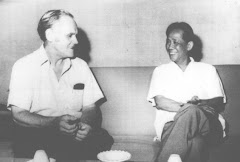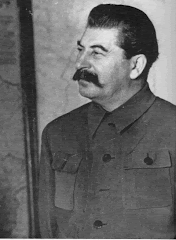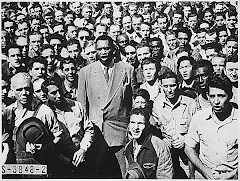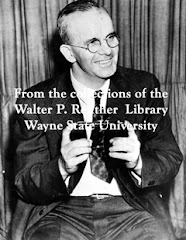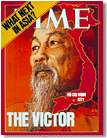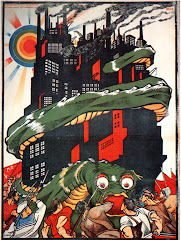A word about TV station WTTW’s commemorative video about Frank Lumpkin, African-American steel worker, long time Communist fighter, proletarian hero: "Lumpkin got another chance to speak for himself in Ten Good Lives, a prize winning TV documentary produced by Jay Shefsky for WTTW, ’Chicago’s Window to the World.’ Lumpkin took viewers for a walk through the closed mill while he told the story of the steel workers’ fight to survive. The documentary was based on a sculpture exhibit, on permanent display at De Paul University’s Monsignor Egan Center. The exhibit includes a bronze bust of Frank in hard hat and working clothes. (This is featured about 4 minutes into the tribute piece. -M.W.) Margot MacMahon, the sculptor, titled the collection, ’Plain hard working, ’ an apt description of Lumpkin. However, his love of useful work is just a part of his love and confidence in working people. That may be the magnet that attracts working people to him, the confidence that together they can win." (Beatrice Lumpkin,Always Bring a Crowd!: The Story of Frank Lumpkin)  (Frank Lumpkin:"My whole life has been around the Communist Party. Everything good that has happened to me has been through the Party. Nothing can make me deny it.") Brother Lumpkin and Save Our Jobs’ first protest can inspire proletarians in the Twin Cities: "On April 22, 1980, the bankruptcy court was hearing the Wisconsin Steel case again. Save Our Jobs held its first demonstration. They came with picket signs to make the workers’ plight known. But no one made a move to raise a sign and begin the picket. Except for Frank, these workers had never, ever held a picket sign in their hand. Then the news media showed up, including a television crew. Frank knew he had to do something. He picked up a sign and began to walk alone. One or two joined him, while the rest stood and watched. As the television camera began to film, one by one other Wisconsin Steel workers picked up signs. They took their first, hesitant steps and then seemed to gain confidence. All they were asking for was what they had already worked for - payment of wages, supplementary unemployment benefits, medical insurance and pensions. Above all, they called for the reopening of their plant. ’For us, this picket line was historic, ’ Frank said later, ’We Wisconsin Steel workers are joining with other working people to fight for our rights.’" (Beatrice Lumpkin, Always Bring a Crowd!: The Story of Frank Lumpkin) Michael Wood |
Tuesday, March 16, 2010
Frank Lumpkin, African-American steel worker, long time Communist fighter and a working class hero
Frank Lumpkin, African-American steel worker, long time Communist fighter and a working class hero, passed away March 1 at the age of 93. In this era of economic crisis, exploitation and war, proletarians in the Twin Cities can draw inspiration from yesteryear’s fightback. Lumpkin's battle against mill closings and his national solution, "the public takeover of the closed plants to provide the jobs and make the steel that the country needs," is a rousing answer to the pending closure of St. Paul Ford Twin Cities Assembly Plant. Frank's serious reading of Marxist texts is a lesson for today's activists.
Beatrice Lumpkin’s Always Bring a Crowd!: The Story of Frank Lumpkin is a handbook for action.
This Black proletarian, master tactician and long-time member of the Communist Party, was honored by PBS, called a "History Maker" by an African-American site and commemorated with the words "Fought for Rights of Workers at Wisconsin Steel" in the Chicago Tribune. In Minnesota, the Gus Hall Action Club dedicated a recent blog post to Frank Lumpkin and the Thoughts from Podunk blog promotes the book
Always Bring a Crowd!
Brother Lumpkin’s battles against the closing of Chicago’s Wisconsin Steel are epic. The plant gates slammed shut in 1980 and the 3500 proletarians were forced to "live a nightmare. Suddenly, workers were out on the street, left with nothing: no jobs, no pensions, no sick pay, no supplementary unemployment benefits, not even pay for the last three weeks they worked." Frank, with 30 years in the mill, fought back! He organized the Wisconsin Steel workers to struggle for the plant’s reopening and their benefits. Lumpkin forged the Save Our Jobs committee and, under his leadership, it "became a crusade that never quit" until victory was won. Comrade Frank was a militant and hardened Marxist-Leninist. (Information and quotes from Always Bring a Crowd!: The Story of Frank Lumpkin by his wife Beatrice)
Chicago public TV station WTTW’s commemorative video about Frank Lumpkin
is excellent:
A superb excerpt from Beatrice Lumpkin’s Always Bring a Crowd!: The Story of Frank Lumpkin about Communists, rank-and file workers’ activity and the forging of Save Our Jobs:
1980: "The plant’s closed. Don’t come in tomorrow. Maybe never."
"Nobody knew what to do. What could you do without an organization? Frank Lumpkin had read about the ’Save Jobs’ committees at the Youngstown, Ohio and Detroit Dodge-Main plants in the rank and file paper, Labor Today, and in the Communist Peoples Daily World. These papers were urging workers to fight plant closings. Frank realized that Wisconsin Steel workers had allies and did not have to fight alone. Fred Gaboury, then editor of Labor Today and a trusted friend (and Communist Party cadre -M.W.), encouraged Frank to take the first step: ’Get a committee going To Save Jobs and start a petition to Congress to reopen the plant.’ Frank thought that was good advice as far as it went. But how could you do that when the in-house union refused to move? He decided to talk it over with some friends from the mill.
"Frank invited some Wisconsin Steel workers to a meeting in his basement. Some he had met during years of African-American rank-and-file groups in the mill such as ’Self-Help’ and ’Getting It Together.’ If ever self-help was needed, that was the time. The meeting was open to any idea for action. The unanimous decision was to organize a ’Wisconsin Steel Workers Save Our Jobs Committee.’ Their first action was to petition the President of the United States, asking him to reopen the mill.
"’Fight or Die’ was the call Frank sent out to his fellow workers. And for 17 years he led the unemployed Wisconsin Steel workers, working without pay, using his house as the first headquarters and his own money when necessary for organizing expenses. No one who knew him would call him a saint, as R.C. Longworth had suggested in the Chicago Tribune financial section. However, it was true that Lumpkin’s dedication was based on his love for working people. Lumpkin’s staying power was strengthened by the belief that workers could change the system if they organized. He often said, ’the system’s got to go.’ He thought it was wrong to allow a few capitalists to close Chicago’s steel mills and ruin the lives of 30, 000 steel workers’ families. His ultimate solution was socialism - production for the good of people, not profits for a few.
"Under Lumpkin’s leadership, Save Our Jobs became a crusade that never quit. The Wisconsin Steel workers took the Save Our Jobs name because their first goal was to reopen the mill. The second goal, which as the years passed became primary, was to get their unpaid benefits. (The WTTW video focused on the fight for the stolen money - M.W.)
"The committee went into action immediately. They circulated their petition to the President and Congress asking them to reopen Wisconsin Steel. The petition let the world know that Wisconsin Steel workers would fight for their jobs. At churches, taverns, beauty shops and grocery stores, wherever steel workers and their families gathered, there was someone collecting signatures to reopen the mill. In a few days, over 4000 steel workers and friends had signed the petition. With thousands in support, Save Our Jobs (SOJ) planned a mass delegation to take the petitions to the state legislature in Springfield, and to Congress in Washington, DC.
"The idea of mass action began to catch on! The in-house union had not organized a labor action in over 30 years. Inside the mill, the rank and file knew how to slow down or ’work to rule’ to make the company live up to the contract. But they had never carried picket signs or demonstrated with other steel workers. After the mill closed, Save Our Jobs members became the most experienced demonstrators in the Chicago area." (Beatrice Lumpkin, Always Bring a Crowd!: The Story of Frank Lumpkin)
Frank Lumpkin, African-American steel worker, long time Communist fighter and a proletarian hero, passed away March 1 at the age of 93. Circulate the tribute
video. Call on May Day books to carry
Beatrice Lumpkin’s Always Bring a Crowd!: The Story of Frank Lumpkin. Check out the Lumpkin's organization, the Communist Party. "If you can't find a leader, be a leader," Brother Frank once said. And his militant statement from decades back is our battle cry: Fight or Die!






